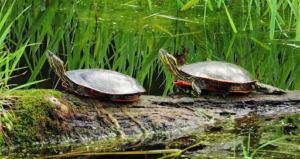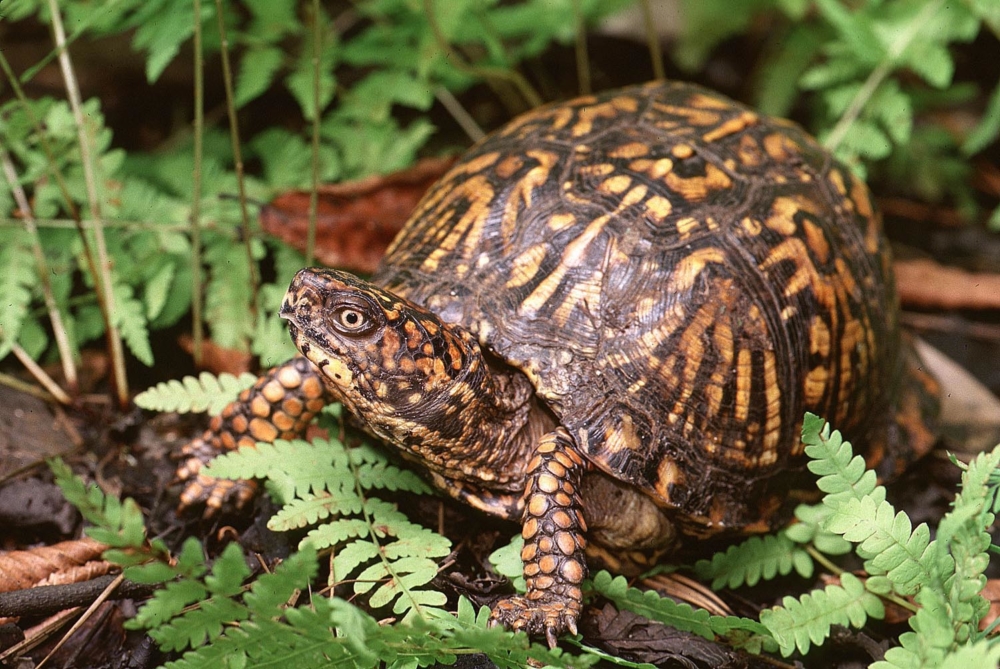Development at 99 Hawley Lane Tabled by Inland Wetlands Commission
Twelve people braved thunder, lightening, and downpours to show up Monday night at the Inland Wetlands Commission Special Meeting to oppose development at 99 Hawley Lane. On The area directly borders a wetland, a type of environment that is especially sensitive to development. Wetlands absorb water, protect against erosion and flooding, and provide wildlife habitat. In fact, a very sensitive resident lives in this area—the Eastern Box Turtle, a state listed species of special concern.
99 Hawley Lane is part of a larger area included in the Natural Diversity Data Base recognized as eastern box turtle habitat. The Natural Diversity Data Base (NDDB) shows approximate locations of species in Connecticut that have been designated as endangered, threatened, or special concern.

Editors Note: A regular meeting of the Inland Wetlands Commission met on Wednesday, July 20th, at which time under Old Business, a vote on the development was tabled until several questions were researched. The Commission is seeking input and answers on:
- The suggestion from the developers to provide a conservation easement for the wetland.
- Marking the area with a split rail fence to delineate wetland area
- Lawn area treatment and runoff
- Snow removal runoff
- Bedrock removal
- Control plan for vegetation
- Box turtle education plan for contractor crews.
The developer, Mountain Development Corporation, site plans show the company plans to build a 110,000-square-foot apartment complex, which will also feature a community building and pool, east of the existing office park and south of the Big Y supermarket. In addition to the apartment building, the complex would include a 2,550-square-foot community building and an outdoor pool for residents. The building would be surrounded on three sides by more than 300 parking spaces.
Raymond Rizio and Christopher Russo, Land Use Attorneys with Russo & Rizio in Fairfield, delivered information on the development before the commission. His presentation was barely audible to those in attendance (he had his back to attendees and did not use a microphone) and his accompanying flip chart was not visible to those in attendance. (Though visible to commission members.)
George Logan, a consultant with REMA Ecological Services, which provides natural resource management, environmental planning, and compliance services throughout the Northeast, was hired by Mountain Development, to do an environmental assessment. Mr. Logan, a charter member and past president of the Connecticut Association of Wetland Scientists, gathered baseline information on the site in January and June of 2020 and 2021. According to Logan, the site he referred to as an urbanized watershed, found the wetlands dominated by organics, having a stable center with edges he termed “in trouble”. Catch basin overflow having an outlet at Johnson Drive.
Logan did not review the entire area that would be impacted by development, but walked all edges closest to the development and assessed both direct and indirect impact on the development. He acknowledged that he was probably was going to come under “blow back” for not doing an assessment on the entire area. In his professional opinion, he felt that the site was a highly functional wetland having lots of animal movement, with aquatic life being isolated and fragmented.
Commission Comments Following Mountain Development Presentations:
Kelly Kerrigan: questioned the maintenance of the properties retention basin.
Manny Philips,an engineering consultant for Russo & Rizio, said that the area around basin has become overgrown, but that he had checked che control function and found basin still operable; there has been some maintenance around the basin, but that there are trees growing around the perimeter.
Kerrigan: will there be any acid rock issues with the removal of bedrock?
Phillips: The rock is at furthest edge of property, and we will do blasting. We will be working with the Fire Department and neighbors, though we don’t see any issues.
Angela Capinera: would you please explain to me more about the herbicide you intend to use at the site?
Logan: the herbicide, which is specific to plants, is Brush-B-Gon is a post-emergent, systemic herbicide.
Editor’s Note: Brush-B-Gon is the commonly used short name for Brush-B-Gon Poison Ivy and Brush Killer manufactured by the Solaris Group, of San Ramon, California. Brush-B-Gon and Roundup, made by the Monsanto Corporation, of St. Louis, Missouri, are both post-emergent, systemic herbicides. Post-emergent means they are applied to weeds that are above the soil and growing. Systemic means they are absorbed by plants and move inside the vascular system. They are easily compared because Brush B Gon is a selective herbicide; Roundup is a nonselective herbicide. BRUSH-B-GON® and ROUND-UP kill woody plants including stumps and vines around homes, cabins, buildings, fence lines, trails, and home rights-ol-way. Controls: Poison Oak, Poison Ivy, Blackberries, Kudzu, Willows, Oak, and other listed woody plants. [6/10/98 Notification] Kills the toughest brushy weeds.
Speakers at the Public Hearing (All opposed, and their issues)
Paula Sweeny: the Commission’s job to protect and defend; developers to make money.
Grace Arpie: this small piece of land is the last of what is left of wetlands in this general area of Stratford. Would like the Commission to hire their own herpetologist or biologist for a review of wildlife; suggested that the Town apply for funds from the state open space and watershed land acquisition program and preserve as open space.
Peter Bow: there will be an impact on groundwater; wetland runoff could have potential problems; any blasting would damage wetlands and would disrupt water table; crushed rock is a larger surface area than bedrock and cause yet more problems.
Laura Dancho: would like to have more information on the animal life; water table; foliage, what native trees to be removed, tree canopy loss; future maintenance and control comes under question after presentation.
Ken Warrenington: his property abuts Big Y; concerned about the runoff from 325 parking spots with toxic chemicals (oil, antifreeze, etc.) and salt from snow plowing; at what cost does economic development take president over residents?
Liz Gramling: would drive wildlife from their home; the natural area absorbs rainwater helps prevent flooding; we are losing green space all over town; we must weigh the outcome of development.
Lisa Salawski: this is an important eco system, and requested a herpetologist to do an in-depth study; egregious that developers can hide their development under the CT Gen. Statute 8-30g; maintenance a problem now.
Karen Rodia: biggest concern is the amount of impervious surface that will change hydrology of wetlands; Veterans Park is town owned protected this should be also; there are already maintenance problems.
Editor’s Note: Veterans’ Park is primarily a wetlands area and is largely inaccessible. The park may be accessed from either Seabreeze Circle or Johnson Lane. There is a trail that winds around the northern perimeter of the park from Seabreeze Circle to Johnson Lane.
Greg Dancho: major construction will remove wildlife; box turtles will not move; these new residents will go into wetlands because they are curious and what to see what is out there; make smart choices for all inhabitants human and animal.
Norah Christensen: don’t trash our own home.
Donna Zacowski: developers don’t seem to be paying taxes, maybe seize the property for town.
Kelly McCarthy: property backs up wetlands, turtles in her yard; Barry Knott said when he pushed for Big Y that it would not impact neighbors; every rainfall looks like a river, has a water easement in her backyard, whole backyard eroding since Big Y. Where does all this rain go? Impossible to catch in a basin; blasting damaged my home; seeds tons of animal life; buffer zone supposed to be 75 feet, what is it now? (Kelly, 250 feet)
Susanna Smaldone: property abuts Big Y; the herbicide is toxic and will affect wildlife eggs.
Written comments emailed to Kelly Kerrigan and read alound at the meeting (all of which opposed the development) were from: Hedi Burger, Katie Bowe, Kimberly Burger, Marilyn Burger, Marca Leigh, Richard and Mary Marris, Jessica Wolf.

